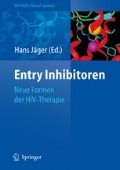Abstract
Maraviroc (MVC) is a compound that has recently been approved by the Food and Drug Administration in the United States and in other jurisdictions for the therapy of patients who suffer from HIV disease (FDA 2007). This approval has been granted for individuals who have failed a variety of first-line treatment regimens and who are now in need of compounds that will act against viruses that have developed resistance against other drugs. One advantage of MVC is that it antagonizes a cellular rather than viral target. Accordingly, resistance against MVC should be relatively difficult to develop on the part of HIV, since substitutions may be required at the cellular rather than viral level, a much more difficult process. In spite of this, concern exists in regard to the ability of MVC to be used in patients who harbour viruses that are tropic for CXCR4 receptors and/or who have virus of mixed or dual tropism i.e. both CCR5 and CXCR4 co-receptors (i.e. dual and/or mixed, D/M) (Lorenzen et al. 2007).
Access this chapter
Tax calculation will be finalised at checkout
Purchases are for personal use only
Preview
Unable to display preview. Download preview PDF.
References
Aggarwal I, Smith M, Tatt ID, et al. Evidence for onward transmission of HIV-1 non-B subtype strains in the United Kingdom. J Acquir Immune Defic Syndr 2006; 41:201–209
Akouamba BS, Viel J, Charest H, et al. HIV-1 genetic diversity in antenatal cohort, Canada. Emerg Infect Dis 2005; 11:1230–1234
Connor RI, Sheridan KE, Ceradini D, Choe S, Landau NR. Change in coreceptor use coreceptor use correlates with disease progression in HIV-1 — infected individuals. J Exp Med 1997; 185:621–628
Delobel P, Nugeyre MT, Cazabat M, et al. Population-based sequencing of the V3 region of env for predicting the coreceptor usage of human immunodeficiency virus type 1 quasispecies. J Clin Microbiol 2007; 45:1572–1580
Descamps D, Chaix ML, Andre P, et al. French national sentinel survey of antiretroviral drug resistance in patients with HIV-1 primary infection and in antiretroviral-naive chronically infected patients in 2001–2002. J Acquir Immune Defic Syndr 2005; 38:545–552
FDA Approves Novel Antiretroviral Drug. FDA. (Accessed October 24, 2007, 2007, at http://www.fda.gov/bbs/topics/NEWS/2007/NEW01677.html)
Lalezari J, Goodrich J, DeJesus E, et al. Efficacy and safety of maraviroc plus optimized background therapy in viremic ART-experienced patients infected with CCR5-tropic HIV-1: 24-week results of a phase 2b/3 study in the US and Canada. 14th Conference on retroviruses and opportunistic infections. Los Angeles, CA, USA; 2007, Abstract 104bLB
Lorenzen T, Stoehr A, Walther I, Plettenberg A. CCR5 antagonists in the treatment of treatment-experienced patients infected with CCR5 tropic HIV-1. Eur J Med Res 2007; 12:419–425
Nelson M, Fäkenheuer G, Konourina I, et al. Efficacy and safety of maraviroc plus optimized background therapy in viremic, ART-experienced patients infected with CCR5-tropic HIV-1 in Europe, Australia, and North America: 24-week results. 14th Conference on retroviruses and opportunistic infections. Los Angeles, CA, USA; 2007, Abstract 104aLB
Roos MT, Lange JM, de Goede RE, et al. Viral phenotype and immune response in primary human immunodeficiency virus type 1 infection. J Infect Dis 1992; 165:427–432
Saag M, Ive P, Heera J, et al. A multicenter, randomized, double-blind, comparative trial of a novel CCR5 antagonist, maraviroc versus efavirenz, both in combination with Combivir (zidovudine [ZDV] / lamivudine [3TC]), for the treatment of antiretroviral naïe patients infected with R5 HIV-1: week 48 results of the MERIT study. Fourth International AIDS Society Conference on HIV Treatment and Pathogenesis. Sydney; 2007, Abstract WESS104
Schuitemaker H, Koot M, Kootstra NA, et al. Biological phenotype of human immunodeficiency virus type 1 clones at different stages of infection: progression of disease is associated with a shift from monocytotropic to T-celltropic virus population. J Virol 1992; 66:1354–1360
Skrabal K, Low AJ, Dong W, et al. Determining human immunodeficiency virus coreceptor use in a clinical setting: degree of correlation between two phenotypic assays and a bioinformatic model. J Clin Microbiol 2007; 45:279–284
Westby M, Smith-Burchnell C, Mori J. In vitro escape of R5 primary isolates from the CCR5 antagonist, UK-427,857, is difficult and involves continues use of the CCR5 receptor. Antivir Ther 2004; 9:S10
Whitcomb JM, Huang W, Fransen S, et al. Development and characterization of a novel single-cycle recombinantvirus assay to determine human immunodeficiency virus type 1 coreceptor tropism. Antimicrob Agents Chemother 2007; 51:566–575
Author information
Authors and Affiliations
Editor information
Editors and Affiliations
Rights and permissions
Copyright information
© 2008 Springer Medizin Verlag Heidelberg
About this chapter
Cite this chapter
Wainberg, M.A., Martinez-Cajas, J. (2008). Maraviroc in Early HIV Disease. In: Jäger, H. (eds) Entry Inhibitoren. Springer, Berlin, Heidelberg. https://doi.org/10.1007/978-3-540-78358-9_11
Download citation
DOI: https://doi.org/10.1007/978-3-540-78358-9_11
Publisher Name: Springer, Berlin, Heidelberg
Print ISBN: 978-3-540-78357-2
Online ISBN: 978-3-540-78358-9
eBook Packages: Medicine (German Language)

